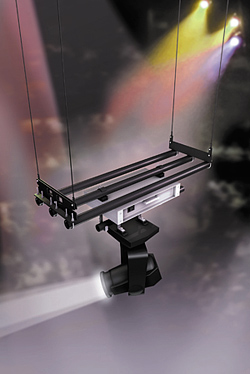Introducing the RCS LightLock

At the recent Professional Lighting and Sound Association show in London, the Royal Shakespeare Company, which is better known for producing interesting versions of the works of William Shakespeare than for its technological innovations, announced the release of a new rigging product that went on to win the first ever PLASA Gold award for product innovation.
Developed by the RSC's head of lighting, Vince Herbert, the RSC LightLock is a stabilizing device, which allows moving luminaires to be rigged on very lightweight hanging or flown structures such as those we use in many TV studios. At last you can rig other fixtures on the same bars as moving lights, without having them wave about all over the place.

RSC LightLock "I started working on a bit of this concept when we were working on the refurbishment of the Royal Exchange Theatre in Manchester," Herbert said. "The idea was to put moving lights onto television pantographs so that we could vary the angle of lighting within cues and make them much easier to maintain. However, that didn't work because of various financial constraints."
THE SWING THEORY
"When we started talking about the RSC's auditorium designs for the new Royal Shakespeare Theatre in Stratford-upon-Avon (currently undergoing a $200 million transformation), Flip Tanner (the Technical Project Coordinator) asked me what I really wanted the rig to look like and what we should do with it," Herbert said. "I had never forgotten the modular cluster lighting idea, and this was the ideal time to put it into place. It was also driven by health and safety, because in the future we won't be climbing up to lights using ladders or cherry pickers. We will want the lights to come down to us. So that's where the thinking started.
"However there is a huge drawback with a small modular lightweight truss system. Basically, if you put a moving light on it, it swings. Flip Tanner and I did an experiment in our Courtyard Theatre to test out how much it would swing and it swung a hell of a lot more than I thought. I realized at that point that I would need to find or design something that would stop the swing. I first started to look for it as I assumed someone must have done this already. When I saw that no-one had produced one, I realized that it was up to me. I had to come up with it!
"In the name of research, I spent a lot of time on a swing in a park in Stratford-upon-Avon. The idea I had was that if you could start yourself swinging by moving your legs, you could stop yourself swinging by moving your legs in the other direction. Testing my theory on the swing must have looked crazy, but it worked. I then had to work on translating this to something that was mechanical and electronic. The theory is that to make something swing you have to put energy into it, so to stop it swinging you put the opposite amount of energy into it. It's a fairly simple exercise in physics.
"Initially I called it the 'it can't be done' system, because everyone I approached said 'It can't be done.' When I built the prototype and it worked, people said it was 'blindingly obvious' so I called it the 'it's blindingly obvious' system. The hardest thing is trying to persuade people, because everyone assumes that if anything is a good idea it must have been done by somebody else."
A BALANCED SYSTEM
The big discovery during that development process was that moving lights really only develop movement about a single axis—essentially the pan axis of the fixture. This enabled the production of a device using just one angular rate sensor to detect the movement of the rigging platform, and a counterbalance mechanism that operates in that single plane.
The 35 pound LightLock unit is rigged directly to a bar or truss, then the fixture is attached to the LightLock. In operation, the device has two states, passive and active. In its passive state, the LightLock continually monitors the structure on which it is rigged to ensure that it is absolutely still. When movement is detected because of the repositioning of a moving light, the LightLock becomes active and the movement of the structure is stopped.
The days of static lighting bars have finally returned.
Andy Ciddor has been involved in lighting for more than three decades as a practitioner, teacher and writer. You can reach him via e-mail c/o TV Technology.
The professional video industry's #1 source for news, trends and product and tech information. Sign up below.
